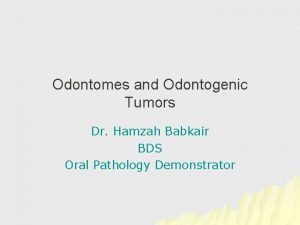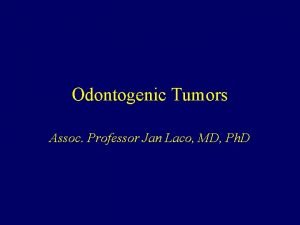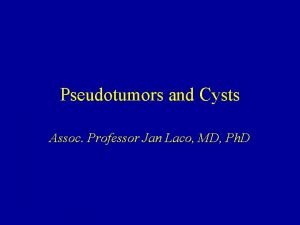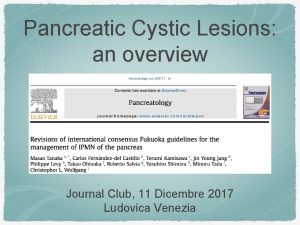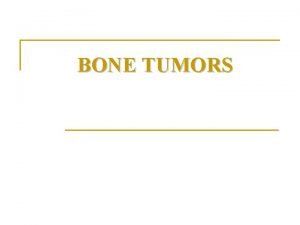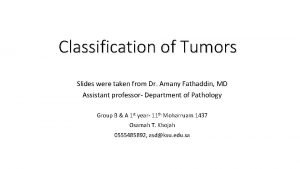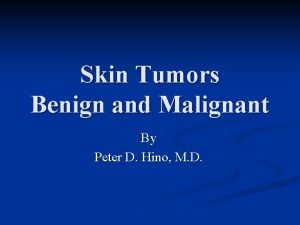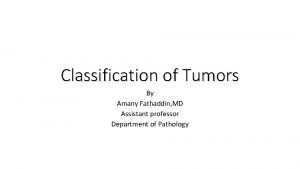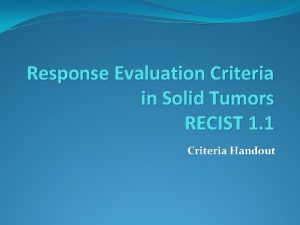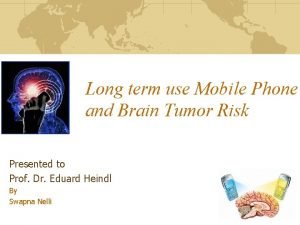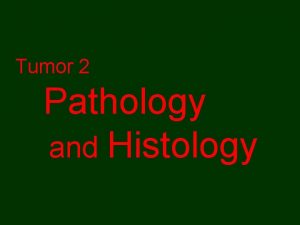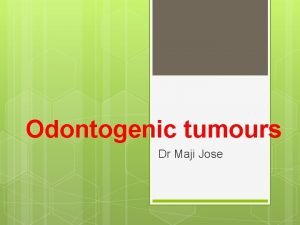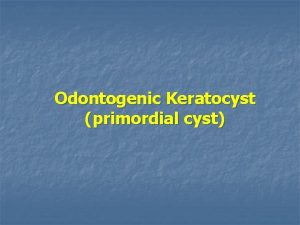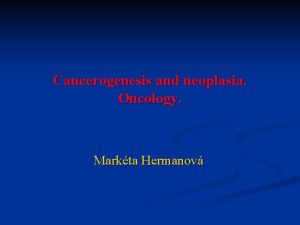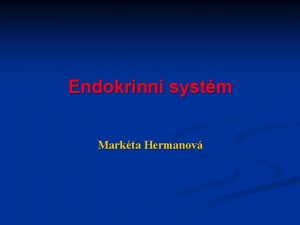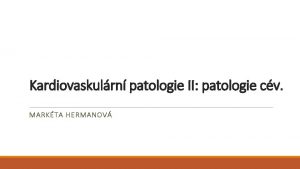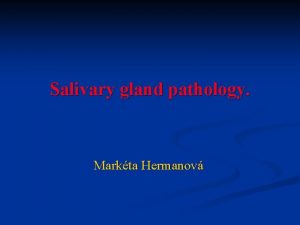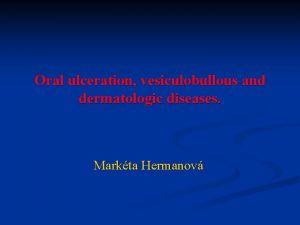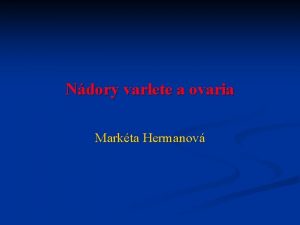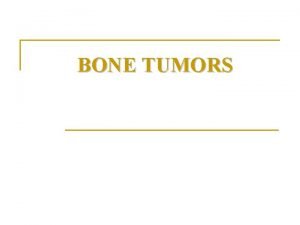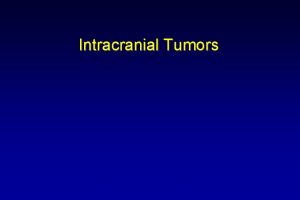Odontogenic tumors Markta Hermanov Odontogenic tumors n Tumors


























- Slides: 26

Odontogenic tumors Markéta Hermanová

Odontogenic tumors n Tumors derived from the dental formative tissues n Uncommon, some are exceedingly rare, represent 1 % of all tumors of oral cavity. n Derived from epithelial, ectomesenchymal and mesenchymal tissues.

Classification of odontogenic tumors n § § According biological behavior Benign Malignant According localisation Intraosseous Extraosseous

Classification of odontogenic tumors - Histogenetic/histomorphological classification Epithelial Without odontogenic mesenchyme With odontogenic mesenchyme § Mesenchymal § Tumors of debatable origin Melanotic neuroectodermal tumor of infancy Congenital gingival granular cell tumor (epulis congenita) n § - -

Benign epithelial odontogenic tumor Without odontogenic mesenchyme Ameloblastoma Squamous odontogenic tumor Calcifying epithelial odontogenic tumor Adenomatoid odontogenic tumor Keratinising cystic odontogenic tumor § With odontogenic mesenchyme Ameloblastic fibroma and fibrodentinoma Ameloblastic fibro-odontoma Odontoameloblastoma Calcifying odontogenic cyst and dentinogenic ghost cell tumor Complex odontoma Compound odontoma §

Benigní mesenchymální odontogenní nádory n Odontogenic fibroma - benign, rare, mandible, maxilla n Myxoma - benign, relapsing, mandible, maxilla n Cementoblastoma - benign, relapsing, associated with the root of a tooth Calcified cementum-like tissue containingscattered cells lying in lacunae

Malignant odontogenic tumors Odontogenic carcinomas Malignant ameloblastoma/ameloblastic carcinoma Primary intraosseous carcinoma (without accociation with oral n mucosa) Clear cell odonogenic carcinoma Malignant variants of other epithelial tumors Malignant change in odontogenic cysts (metastatic spreading into lymph nodes, lungs, bones, …) Odontogenic sarcomas Ameloblastic fibrosarcoma Ameloblastic fibro-odontosarcoma n

Ameloblastoma n Benign, local invasive, rellapse after years n Subtypes: - Solid/multicystic Extraosseous/peripheral (soft tissues above mandibula, older - patients) - Desmoplastic (anterior maxilla and mandible) Unicystic

Solid multicystic ameloblastoma n n n 3. -5. decade, molar region/ascending ramus of the mandible (70 %) + posterior maxilla Two main histological patterns: follicular and plexiform Variants: basaloid, granular, acantomathous, keratoacantomathous Columnar/cuboidal peripheral cells considered to be preameloblasts) Mature fibrous stroma, does not contain enamel or dentin Treatment: surgical resection with a margin of

Unicystic ameloblastoma n Younger patients n Often associated with an unerupted tooth, macroscopically looks like dentigerous cyst Cystic lesion lined by ameloblastomatous epithelium, with palisading of basal layer of the cells Luminal amd mural variants Luminal variants treated by enucleation and curettage; mural variants treated by resection n

Other benign epithelial odontogenic tumors n - - Squamous odontogenic tumor benign, locally aggressive, rare, in mandible, M˃F, 4 th decade nests of squamous epithelium in fibrous stroma Calcifying epithelial odontogenic tumor (Pindborg´s tumor) benign, locally aggressive, rare, in mandible, M˃F, 4 th decade (molar and premolar region) sheets of pleomorphic epithelial cells, amyloid-like material, calcification assoc. with Gorlin-Goltz syndroma

Other benign epithelial odontogenic tumors n - - n - Adenomatoid odontogenic tumor benign, hamartoma? , 2 nd, 3 rd decade, anterior part of the maxila, often assoc. with unerupted tooth solid nodules and tubular structures + eosinophilic material, calcification; treated by enucleation Keratinising cystic odontogenic tumor = odontogenic keratocyst (WHO 2005 true tumor) benign, locally aggressive Mandibular angle (50 %), 60 % relapsing; treated by enucleation?

Odontogenic keratocysts n Bimodal age distribution – 2 nd-3 rd decades and 5 th decade n Few symptoms; cause little expansion; may reach large size n Unilocular/multilocular radiolucency; may mimic dentigerous cyst n More common in mandibula than in maxila n Tendency to recur n May be multiple; associated with nevoid basal cell

Naevoid basal cell carcinoma syndrome (Gorlin-Goltz syndrome) n AD n Multiple naevoid BCC + multiple odontogenic keratocysts + skeletal abnormalities (rib abnormalitites, vertebral deformities, polydactyly, cleft lip/palate) + calcified falx cerebri + brain tumours n Mutation in tumor supperssor gene PTCH (9 q) n Mutations of PTCH affect the normal function of Hedgehog signalling pathway n Hedgehog signalling pathway controls transcription of the genes involved in the developlment, patterning, and growth of numerous tissues and organs

Odontogenic keratocysts n Thin, easily torn wall n Lined by an even layer of parakeratinized squamous epithelium n Palisaded basal cell layer n Satellite cysts in capsule n Tendency to recur due to difficulty of surgical removal thin, easily ruptured wall Projection into cancellous spaces easily torn Satellite cysts in capsule n - Cyst enlargement involves Focal areas of active growth of the cyst wall Extension of proliferating areas along cancellous spaces Production of bone resorbing factors

Odontogenic keratocyst

Ameloblastic fibroma, fibrodentinoma, fibro-odontoma n n n Benign tumors nádory, fibro-odontom v. s. hamartoma Well circumscribed, mainly in 1 st and 2 nd decade, posterior mandible Odontogenic epithelium + cellular mesenchymal tissue Fibrodentinoma contains dentin, fibro-odontoma enamel and dentin Must be distinguished from ameloblastoma, different treatment (curretage)!

Calcifying cystic odontogenic tumor = calcifying odontogenic cyst (Gorlin´s cyst) n n n WHO 2005 true tumor Wide age range Anterior mandible, maxilla, gingiva Cyst lined by ameloblastic epithelium, „ghost cells“→calcification, „dentinoid“ at basal layer of epithelium in supporting fibrous tissue Tend to recur, sometimes associated with ameloblastoma Treatment: enucleation

Odontomas (true tumors? , hamartomas, congenital anomalies? ) n n Invaginated (dens-in-dente, dens invaginatus) Evaginated (dens evaginatus) Enamel pearls/enamelomas „Double tooth“/geminated odontoma Complex odontoma n Compound odontoma n

Complex odontoma n Develompmental lesion resulting in disorganized mass of dental tissue n 2 nd/3 rd decade, predominantly molar region mandible, omay overlie/replace a tooth

Compound odontoma n 1 st/2 nd decade; predominantly anterior maxilla n Developmental lesion resulting in the formation of a bag of discrete denticles n Denticles comprise enamel, dentine, cementum, and pulp in their normal anatomical relationship n Separate dinticles identifiable on radiograph

Melanotic neuroectodermal tumor of infancy Synonyms: melanotic progonoma, retinal anlage tumor, … n n n Very rare Tumor of infancy, 80 %<6 month, 95 % <1 year of age F: M: 2: 1 maxilla>mandible>skull Rapidly growing pigmented mass Local recurrences, metastatic (7 %): lymph nodes, liver, bones

Congenital epulis of the newborns – congenital gingival granular cell tumor: § Incisor region of the maxilla, F>M § Closely packed granular cells covered by flattened squamous epithelium Benign lesion, unknown etiology (reactive? , …. neoplastic? ? ? , but unrelated to granular cell tumor of the tongue ) §

Congenital epulis of the newborns – congenital gingival granular cell tumor

Take home message n Odontogenic tumors are rare, but occur n NOT ONLY ameloblastoma n Often benign x locally aggressive n Not to rely on radiography, histopathological examination of diagnosis is necessary! n Secondary inflammation can cover some signs

Thank you for your attention……. .
 Odontogenic tumors
Odontogenic tumors Ameloblastoma rtg
Ameloblastoma rtg Odontogenic tumors classification
Odontogenic tumors classification Markta
Markta Lengua geográfica
Lengua geográfica Pathway of odontogenic infection
Pathway of odontogenic infection Abcsses
Abcsses Exocrine tumors of pancreas
Exocrine tumors of pancreas Benign tumors in the uterus
Benign tumors in the uterus Thyroid tumors
Thyroid tumors Bone tumors
Bone tumors Acromely
Acromely Local invasion
Local invasion Malignant and benign tumors
Malignant and benign tumors Spinal cord
Spinal cord Paresthiasis
Paresthiasis Classification of tumors
Classification of tumors Response evaluation criteria in solid tumors (recist)
Response evaluation criteria in solid tumors (recist) Brain tumors
Brain tumors Prostate adenocarcinoma perineural invasion
Prostate adenocarcinoma perineural invasion Classification de robbins
Classification de robbins Enneking
Enneking Codman üçgeni
Codman üçgeni
